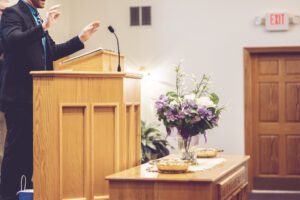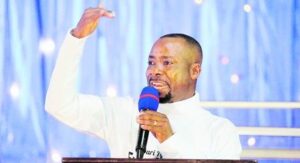
LOUISVILLE, Ky. (BP)–There are few biblical stories as well-known as the one of Sodom and Gomorrah.
Ask any believer or non-believer, and they’re likely to know at least something about the ancient cities’ wickedness and sinfulness.
However, some wonder if they really existed. Were there actually two cities destroyed by God for their wicked acts?
Archaeologist Bryant Wood believes so. Wood, an archaeologist with the Associates for Biblical Research and the editor of Bible and Spade magazine, gave a series of lectures Sept. 25-27 at Southern Baptist Theological Seminary where he showed archaeological proof for several Old Testament events. One of the lectures dealt with Sodom and Gomorrah.
“Even people who don’t know anything about the Bible know something about Sodom and Gomorrah and the wickedness of those places,” he said. “Did they exist? Were they real? Did this really happen? I think archaeology can provide some answers to those questions.”
Wood, who holds to the inspiration and inerrancy of Scripture, said evidence for the ancient cities can be found in land that is located southeast of the Dead Sea. In the 20th century, archaeologists excavating in the region found five ancient cities that are now identified as Bab edh-Dhra, Numeira, Safi, Feifa and Khanazir.
While some archaeologists contend that the remains of Sodom and Gomorrah now lie underneath the Dead Sea, Wood argues that the aforementioned five cities are indeed found in the Bible, only with different names. He pointed to Genesis 14:8, where five cities are mentioned: Sodom, Gomorrah, Admah, Zoboiim and Bela (also called Zoar).
Bab edh-Dhra, Wood said, was once Sodom; Numeira was Gomorrah. He said that archaeological evidence at both sites shows that the cities were destroyed by fire around 2,100 B.C., which would cohere with the biblical time of Sodom and Gomorrah’s destruction. Just as telling, geological evidence shows that there was an earthquake during the time, as well.
“Everywhere the archaeologists dig within the site, they find the evidence for a massive destruction by fire,” Wood said.
The fire evidence is very detailed, he said. While excavating one ancient building, archaeologists discovered “that the fire did not start on the floor of the building, but rather on the roof of the building. They found evidence for the collapse of the roof. The roof beams had burned first and then collapsed inside the building.”
A cemetery located near the city was burned as well, suggesting that the fire was not started by raiders. Cemeteries were considered sacred.
Why would both the city and a local cemetery be burned?
“Basically, (archaeologists) have no explanation for this,” Wood said. “But the Bible does give us an explanation, doesn’t it? It says that God rained down this burning material on the cities from the sky. Not only the cities, but the area surrounding the cities. Here we have graphic evidence, that, yes, something from above came down onto these houses, setting the roof on fire and eventually burning the entire structure.”
Wood suggested that the fire may have come from the effects of an earthquake. He said that a volcanic eruption is not likely because no evidence has been found.
“The geologists who studied these sites — both Bab edh-Dhra and Numeira — say the earth’s surface shifted at the very time the cities were destroyed and burned by fire,” he said.
It is possible, he said, that God caused petroleum deposits under the earth to escape though the earthquake’s fault lines, after which they were ignited and then fell back down onto the cities.
Another interesting find pertains to Sodom’s city gate. Archaeologists discovered not just one, but two gates along the city’s wall. However, one of them had been sealed. Wood said the Bible provides a possible solution to the mystery. In Genesis 14 — years before the final destruction — Sodom was destroyed for the first time in a battle.
“The destruction of this gate, I believe, is connected with Genesis 14,” he said. “Rather than rebuild the gate, the citizens of Bad edh-Dhra decided they would block it up and build a new gate. They built their new gate at the northeast end of the site.”
That new gate, Wood said, is referred to in the story of Sodom’s second destruction.
“When the angels came to Sodom to warn Lot of the coming destruction, they found Lot sitting in the gate,” he said. “This must be the gate. It was the only gate in use at the end of the life of the city.”
The Bryant Wood lectures can be heard on the seminary’s web page at https://www.sbts.edu/bryantwood.html.
–30–













